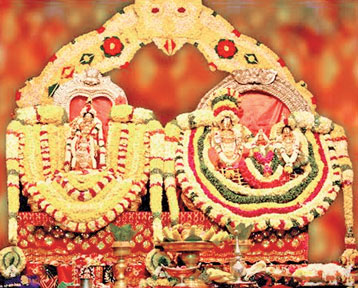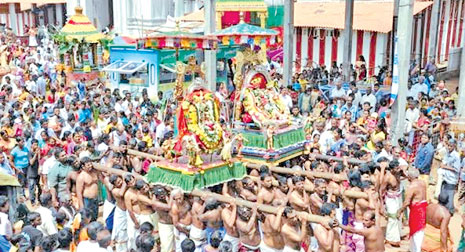|

The front view of the Munneswaram temple |
Magnificence of Sri Munneswaram
by P. Krishnaswamy
Among the Shiva temples in Sri Lanka, Sri Munneswaram is preeminent
and is one of the five ‘pancheswarams’, the five most hallowed Shiva
shrines, believed to have existed from prehistoric times, showering
blessings on all devotees, low and high alike. The Temple is located
just two miles off Chilaw on the Chilaw-Kurunegala road and is popularly
known as the ‘Munneswaram Maha Devale’ among local devotees.
National leaders including the world’s first woman Prime Minister
Sirimavo Bandaranaike, former Presidents Chandrika Kumaratunga and
Ranasinghe Premadasa were frequent visitors, seeking the blessings of
Lord Shiva. President Maithripala Sirisena, according to temple priests,
has also become a VVIP returnee.
Novice pilgrims often mistake Sri Munneswaram for the Munneswaram
Badrakaliyamman Temple, ignorant of the historic and significant
difference of the two places of worship. For one, the consecration of
the Munneswaram Badrakaliyamman Temple happened significantly later than
Sri Munneswaram, and in recent years has received much media flak over
its controversial animal sacrifice traditions. Many other temples
surrounding the Munneswaram Temple are also relatively new additions.
Sri Munneswaram stands magnificent in a serene and quiet setting,
with a vast pond dotted with lotus, water lilies and fascinating foliate
providing a spectacular eastern backdrop, and the panoramic expanse of
paddy fields propping up the west and south, while vegetations with
dotted smaller temples and houses give additional depth and colour to
the surrounding areas.
 The
architectural tradition of the temple, as well as the intricate
sculptures and mouldings, resembles the style of the imperial Chola
rulers of Thanjavur, South India. The
architectural tradition of the temple, as well as the intricate
sculptures and mouldings, resembles the style of the imperial Chola
rulers of Thanjavur, South India.
Lord Shiva is the presiding deity appearing in the form of Shiva
Linga, while standing next to Him in the sanctum sanctorum is Annai
(Mother) Vadivazhagi, the divine consort, the bestower of eternal bliss,
knowledge and immortality.
While other deities normally found in Shiva temples are also there,
the most significant feature of Sri Munneswaram is that it houses the
statues of the 63 saints known in Tamil as ‘nayanmars’ (saint poets )
who sang hymns on the glory of Lord Shiva.
While an average of 5000 pilgrims visit the temple everyday what
emerges as fascinating is the fact that a large majority of them, around
75 per cent are Buddhists. This is confirmed by temple authorities, who
also say that 20 percent of the pilgrims are Hindus, and the balance
comprises Muslims and Catholics.
All the pilgrims, irrespective of religious differences visit the
Temple to receive the blessings of Lord Shiva, and all of them come
bearing gifts, usually trays with offerings of fruits, flower garlands,
incense sticks and camphor. These gifts are often purchased by the
hoards of boutiques in the vicinity of the Temple and are priced Rs.200
and above.
Annual ‘Mahotsavam’
Indian pilgrims, aware of Lord Rama’s historical links with the
temple, also come in large numbers.
The annual ‘Mahotsavam’, the month-long main festival normally begins
in the middle of August, which is the beginning of the Tamil month of ‘Avani’.
On the days following the flag-hoisting ceremony, which happens on the
first day of the Festival, processions set off from the Temple, with the
deities transported in colourfully decorated chariots, to the hypnotic
sounds and sights of traditional drums and the ‘nathaswaram’
(traditional Hindu flute), Kavadi dancing (in which devotees carry
semicircular wooden contraptions decorated with peacock feathers, on
their shoulders) and other traditional dances.
 Each
day of the celebration is held under the auspices of families of patrons
or villages that traditionally belonged to the temple. Each
day of the celebration is held under the auspices of families of patrons
or villages that traditionally belonged to the temple.
The Festival lasts for 28 days from mid- August to September, with
devotees thronging in their thousands to make their offerings and invoke
the blessings of the deities. In traditions are that similar to Buddhist
pageants, the penultimate day of the Festival is devoted to the water
cutting ceremony and the final day sees the Great Chariot carrying the
sacred deities along crowded streets.
It is really a grand day for the devotees who converge in their
thousands to offer and receive the blessings of Lord Shiva, divine
consort Annai Vadivazhagi and other deities who are part of the
procession, all celestially and magnificently decorated and illuminated.
The Shiva Linga
Chief Priest of the temple Bramasri S.Padmanaba Kurukkal, the history
of Sri Munneswaram Temple dates back to centuries before the arrival of
Prince Vijaya to Lanka.
King Ravana, the King of Lanka at that time and an ardent devotee of
Lord Shiva, is believed to have worshiped in these temples. Mention has
been made about it in the ‘Skandapuranam’ and other ancient Hindu
religious scripts.
According to other records, the hero of the Hindu epic ‘Ramayana’,
Lord Rama, believed to be the incarnation of Lord Vishnu, is said to
have worshiped the Shiva Linga at Munneswaram before consecrating it in
the temple. There are other shrines linked to Ramayana like Seetha Eliya
and the Koneswaram Shiva Temple in Trincomalee. But there are no written
or epigraphic records other than the inscription believed to have been
made in the Temple during the reign of King Parakramabahu VI, elaborates
Padmanaba Kurukkal.
According to a booklet put out by the Kurukkal titled ‘An Inscription
from the Munneswaram Siva Temple’ based on the research work of
A.Velupillai, Senior Lecturer in Tamil, University of Ceylon, “A Tamil
inscription of four long lines is found above the foundation of the
Munniswaram Siva Temple. The inscription does not mention anything about
the beginnings of the Temple. The Temple is said to be already famous
when the inscription was made.”
|

The Munneswaram Gods being carried in procession by devotees |
According to the booklet, Parakrama Bahu VI, the descendant of the
great Sri Sangabo, who was ruling over Ceylon from his Capital
Jayawarthanapura, upon hearing the history of Muneeswaram. had
accomplished the renovation of the temple and directed that a monthly
allowance be made from the government coffers for the daily performance
of poojas.
The booklet further records that Munnesvaram fell on the evil days
with the decline in the power and influence of the Sinhalese monarchy
and the corresponding rise of Portuguese power in the Kingdom of Kotte.
Kirthi Sri Rajasingha who was ruling over Kandy from his capital at
Kundasala learnt of the greatness of Sri Munneswara and of its
destruction by the Portuguese and invited sculptors from South India for
the reconstruction of the Temple.
Chief Priest Padmanaba Kurukkal says according to other reliable
records and evidence available, the Munneswaram Temple was not
completely razed to the ground and that a Catholic church functioned in
the very premises. The Shiva Linga, which could not be uprooted or
removed by them, was left to remain in the same spot where it was
located.
The Linga is there even now at the reverse side of the sanctum. This
was the darkest period of the temple and the Portuguese had their church
functioning in the premises for about a century, he explains. |

